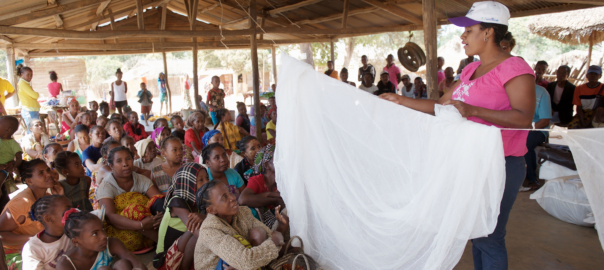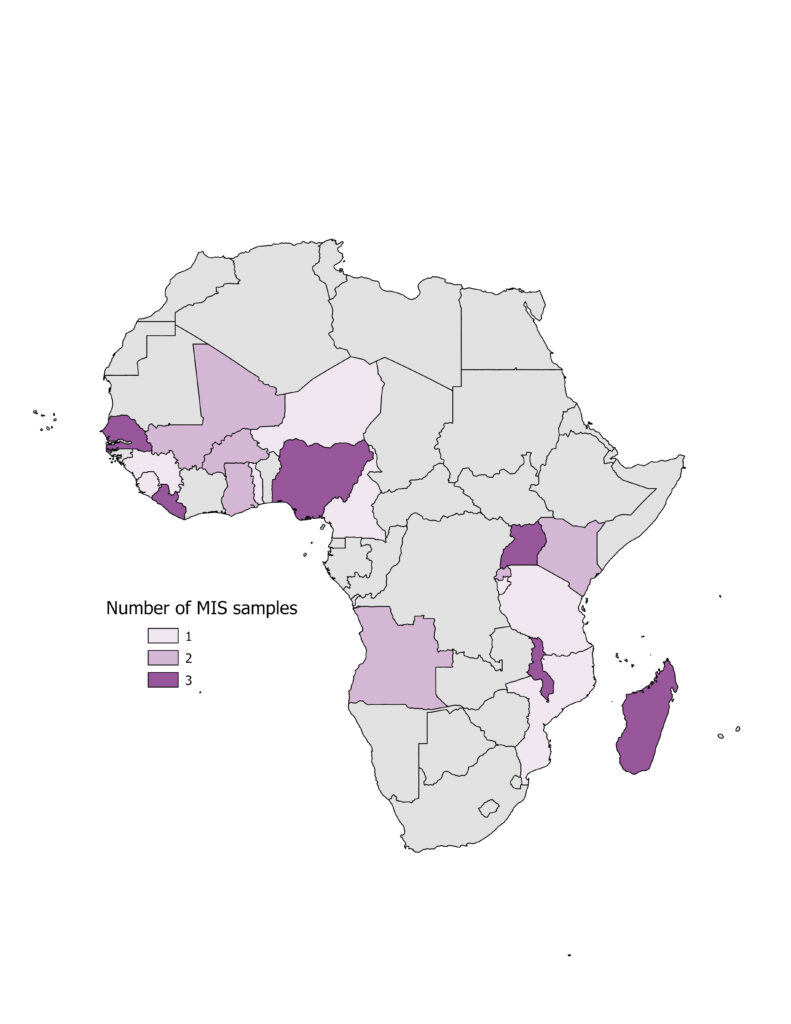Harmonized Malaria Indicator Survey Data Now Available through IPUMS DHS

Sustainable Development Goal (SDG) target 3.3 aims to end epidemics including malaria. The WHO Global technical strategy for malaria 2016-2030 sets targets to:
- Reduce malaria case incidence by at least 90% by 2030;
- Reduce malaria mortality rates by at least 90% by 2030;
- Eliminate malaria in at least 35 countries by 2030; and
- Prevent a resurgence of malaria in all countries that are malaria-free.
DHS Program data are essential for monitoring malaria prevalence, for example through diagnostic blood testing of children under age 5. The DHS Program also frequently collects information on malaria prevention measures such as household use of insecticide-treated nets and indoor residual spraying, popular beliefs about causes and symptoms of malaria, and malaria treatment, especially of pregnant women and acutely ill young children.
Malaria questions are often, but not always, included in standard DHS surveys, and are the primary focus of Malaria Indicator Surveys (MIS), which have been fielded in 20 countries since 2006. MIS surveys incorporate many more questions about malaria, including hundreds of sample-specific queries, such as whether and how respondents have heard public health messages about malaria.
Now, IPUMS DHS is distributing harmonized variables from 38 MIS samples from across Africa in addition to DHS samples already available (see map of coverage in Figure 1). MIS samples in IPUMS DHS include approximately 700 consistently coded variables. Faced with the wealth of MIS data, IPUMS DHS prioritized variables that matched standard DHS Program indicators and non-standard variables already included in the IPUMS DHS database.
Variables in IPUMS DHS have consistent names and codes across all samples (both MIS and DHS) and extensive online documentation. Every variable comes with documentation that explains what the variable means, how it compares across samples, its sample-specific question wording and question ordering, and which respondents were asked the question. Data users can also see the raw frequencies for any variable.
From the IPUMS DHS homepage, data users can click “Browse and Select Data” to see which variables are available from which samples. After choosing the unit of analysis, click “select samples” and select “All Malaria Indicator Surveys” to explore variable availability and documentation for all 38 MIS samples.
Registered DHS data users can now seamlessly combine malaria variables collected in both DHS and MIS surveys and download them in a single customized data file in their preferred format, whether Stata, SAS, SPSS, CSV (comma delimited), or ASCII. IPUMS DHS makes it easy to extend time-series analysis for one country and conduct broader comparative analyses across several samples and countries. IPUMS DHS enables data users to explore the maximum number of samples and draw robust conclusions.
For guidance on using IPUMS DHS, from selecting samples and viewing variable documentation to choosing your file format, consult the IPUMS DHS User Guide.
Harmonization of MIS data in IPUMS DHS was made possible by a supplemental grant on Climate Change Effects on Health, awarded in 2023 by the Eunice Kennedy Shriver National Institute for Child Health and Human Development (NICHD).
Special thanks to our guest blog contributor from IPUMS DHS:
Dr. Miriam King, Senior Research Scientist, Institute for Social Research and Data Innovation, University of Minnesota, Twin Cities
IPUMS DHS is a system that makes it easy to find and review thousands of DHS and MIS survey variables and to download a single fully harmonized data file with only the variables and samples that interest you. IPUMS DHS currently includes variables from 233 DHS and MIS survey samples from 51 countries, with more samples to be released soon.
Feature image © December 2018, PMI Flickr. Social mobilization in the distribution site of Andohaomby, Port Berger district, Sofia region, Madagascar


